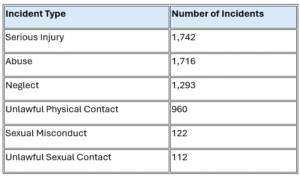The Top 10 NDIS Providers in 2024: Difficulty at scale and lessons for the sector
January 22, 2025

The Top 10 NDIS Providers in 2024: Difficulty at scale and lessons for the sector
There’s a persistent rumour in the disability sector that the National Disability Insurance Agency (NDIA) is slowly corralling services into just a handful of mega-providers. But does that theory hold water? Our look at the top 10 attendant care non-profits suggests it might not. Despite commanding over billions in combined revenue, these organisations still occupy a surprisingly small slice of total NDIS payments and the same difficult operating environment, albeit at substantial scale.
In this article, we’ll explore:
- Top 10 providers’ NDIS market share and growth.
- Adjusted operating performance and the implications for providers.
- The impact of pricing and viability on sector consolidation.
- Recommendations for better operational insight (spoiler: it involves real-time dashboards).
How big are our top 10?
To generate these insights, we first selected provider payment data from the top 10 not for profits with a significant focus on attendant care. This amounted to over $ 2 billion in NDIS revenues and $ 3.3 billion in total revenues. Clearly, significant institutions with a societal impact. Despite this, no provider exceeds a 1.3% market share, with the entire group accounting for roughly 6% of NDIS payments. In the period we analysed, NDIS market share shrunk by an annualised rate of 5.1%.
This data gives us something of a reality check when contemplating a grand merger. Despite persistent rumours, the present market concentration data (as measured by the Herfindahl–Hirschman Index) shows extremely low concentration, with a marginal trend toward less concentration.
Growth, But at What Cost?
Our major providers reported overall payment increases in the year of just over 2.5%, which readers will note is less than plan indexation and the broader growth in the sector. Regardless, it is important to note that this was achieved while managing a portfolio of 1000s of participants and billions in revenue.
Despite this, nine out of ten providers posted negative adjusted operating results once we normalised their results. A brief note of this: these large NFPs have consolidated portfolios with many products. NDIS revenue represents 70% of their income, driving their overall performance. We’ve adjusted their financial statements to estimate an “operating result”. Essentially, removing or adjusting financial income, donations (less fund-raising expenses), one off or terminal subsidies, and revenues without associated expenses. We did this to determine how NDIS not for profits would function without revenues unrelated to what they could generate directly in their operations. This gives us a view into what the sector at large is facing and who is more dependent on NDIS service revenues.
What we see is an average operating loss of 5.8%, with 9 out of 10 major providers showing an adjusted operating loss and one showing a marginal operating profit. This reduces to -4.5% when adding back donations (minus funding raising expenses), but most providers cannot depend on this source to achieve sustainability.
If the country’s largest and best-known disability organisations generate losses on their everyday NDIS supports, smaller outfits may be under similar or worse margin pressures. Unless major structural changes occur (e.g. unit price increases or drastically lower overhead), we see no sign of effortless profitability anytime soon.
Why Consolidation Is Unlikely
A major source of anxiety is whether the Agency will compel the sector to merge or cause large providers to acquire smaller providers en masse. Our analysis indicates that’s unlikely:
- Extremely unconcentrated market: The effort to consolidate the NDIS would be gargantuan, and the present growth rates of the top 10 show that they are losing market share. This indicates that the infrastructure to handle vast participant transfers is immature.
- Minimal Scale Advantage: Our data shows a moderate negative correlation between NDIS revenue and operating profit. Re-stated, scale benefits are yet to materialise in the scheme. This is obvious in the context of limited operating margin in a scheme heavily dominated by labour.
- Thinning balance sheets: While many of the top 10 boast assets in the 100s of millions, they have been continually eroded by marginal operating performance over the years. Boards may be reluctant to increase the surface area of their risk.
This is, in effect, a perfect storm of issues. Firstly, from the government’s perspective, increased market concentration increases the bargaining power of major providers. In a market where price is extremely contentious, this seems to be counter to their interests. Indeed, a merger conspiracy could create a “too big to fail” scenario in the sector, which funders would be keen to avoid. Secondly, given the level of market concentration, it would require extreme disruption to participants, which would raise concerns about choice and control, which the agency is focused on safeguarding.
From a Board perspective, while mergers among non-profits don’t require huge purchase outlays, they require synergy—merging overhead, staff structures, and intangible assets. Without guaranteed NDIA price relief (or filling SIL vacancies), combining two deficit-running NFPs may simply merge red ink. Our data indicates that most losses are driven by labour efficiency and SIL vacancy. While there is an argument for consolidated corporate overhead, it is typically only a part of provider losses rather than a determinant.
While we expect to see continued mergers, we believe this will be driven by failing operating profits of large providers rather than a grand edict from the NDIS. It seems unlikely that successful smaller providers will be subject to compulsion by the NDIA.
Making Sense of Unit Rates
Having read 100s of annual reports, we’re noticing that a single strategy to alleviate financial concerns. Many providers are focused on lobbying the NDIA for higher pricing. What is concerning is that this strategy has failed to yield material results since scheme inception, and with budgetary pressure higher than ever on the scheme, this may be unlikely.
Consider if the examined providers generated all their revenue from the NDIS rate. To achieve break even, when accounting for likely SCHADS and operating increases, the unit rate will need to increase by 16.6% next year to achieve breakeven. I strongly doubt this is likely to occur and as such, waiting out the NDIA doesn’t appear to be a reasonable strategy.
The Role of Operational Efficiency
Our data strongly suggests operational behaviour—roster management, overhead levels, claim accuracy—can make or break you in a low-margin environment. That’s where real-time visibility into labour costs and plan usage becomes indispensable.
Our Dashboard:
- Our platform ingests daily rosters, timesheets, participant allocations, and normalises them against plan budgets or unit rates.
- Visual alerts if staff hours look abnormally high relative to the participant’s allocated budget.
- By spotting potential overservicing or missed supports early, providers can reduce the risk of unprofitable service patterns and ensure compliance.
Put plainly: if the top 10 are scraping by—or operating at a loss—then precision in day-to-day management is essential for everyone else.
Conclusion & Key Takeaways
- Bigger is harder: Contrary to conspiracy theories, the largest NDIS providers collectively hold a modest market share and often run at deficits (once you remove donations and one-off subsidies).
- Consolidation? With negative margins, there’s little room for large-scale buyouts or expansions. The data doesn’t suggest imminent “mega-mergers.”
- Higher Prices vs. Better Management: If NDIS rates remain unchanged, many will keep lobbying for an increase. But even if that comes, efficient cost structures and accurate service claims will still be critical.
- Visualise & Optimise: Granular dashboards—tracking revenue vs. shift costs in real time—can help providers survive in an environment where every hour worked must be accounted for.
Bottom Line: The top 10’s operating results hint at a sector under serious cost pressure. Whether you’re a large non-profit or a local community provider, you can’t rely solely on scale or donations. Proactive financial stewardship, operational clarity, and data-driven decisions remain the best path forward.
Share this article:
Continue reading Empathia Insights
Kafkaesque: The Moral Hazard at the Heart of SIL
Kafkaesque: The Moral Hazard at the Heart of SIL Dean Bowman November 18, 2025 Supported Independent Living The Federal Court's...


